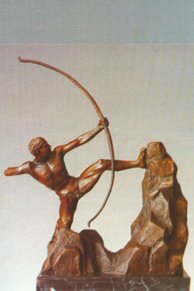Eshani, Esanī, Esani, Eṣaṇī, Eshsani: 3 definitions
Introduction:
Eshani means something in Hinduism, Sanskrit, Buddhism, Pali. If you want to know the exact meaning, history, etymology or English translation of this term then check out the descriptions on this page. Add your comment or reference to a book if you want to contribute to this summary article.
The Sanskrit term Eṣaṇī can be transliterated into English as Esani or Eshani, using the IAST transliteration scheme (?).
In Hinduism
Dhanurveda (science of warfare)
Source: Wisdom Library: DhanurvedaEṣaṇī (एषणी) refers to a weapon (“iron arrow”). It is a Sanskrit word defined in the Dhanurveda-saṃhitā, which contains a list of no less than 117 weapons. The Dhanurveda-saṃhitā is said to have been composed by the sage Vasiṣṭha, who in turn transmitted it trough a tradition of sages, which can eventually be traced to Śiva and Brahmā.

Dhanurveda (धनुर्वेद) refers to the “knowledge of warfare” and, as an upaveda, is associated with the Ṛgveda. It contains instructions on warfare, archery and ancient Indian martial arts, dating back to the 2nd-3rd millennium BCE.
Languages of India and abroad
Pali-English dictionary
Source: Sutta: The Pali Text Society's Pali-English DictionaryEsanī, (f.) (fr. iṣ) a surgeon’s probe M.II, 256. (Page 162)

Pali is the language of the Tipiṭaka, which is the sacred canon of Theravāda Buddhism and contains much of the Buddha’s speech. Closeley related to Sanskrit, both languages are used interchangeably between religions.
Sanskrit dictionary
Source: Cologne Digital Sanskrit Dictionaries: Monier-Williams Sanskrit-English Dictionary1) Eṣaṇī (एषणी):—[from eṣaṇa > eṣa] f. an iron or steel probe, [Suśruta]
2) [v.s. ...] a goldsmith’s scale, [cf. Lexicographers, esp. such as amarasiṃha, halāyudha, hemacandra, etc.]
Sanskrit, also spelled संस्कृतम् (saṃskṛtam), is an ancient language of India commonly seen as the grandmother of the Indo-European language family (even English!). Closely allied with Prakrit and Pali, Sanskrit is more exhaustive in both grammar and terms and has the most extensive collection of literature in the world, greatly surpassing its sister-languages Greek and Latin.
See also (Relevant definitions)
Starts with: Eshanika, Eshanike, Eshanin, Eshaniy, Eshaniya.
Ends with: Bhuvaneshani, Keshani, Maheshani, Manthareshani, Neshani, Pareshani, Peshani, Pradeshani, Preshani, Sampreshani, Turamgadveshani, Uccheshani, Vesani, Vidveshani, Vighneshani, Yantrapeshani.
Full-text: Eshanika, Sutragandika, Esana, Gandupada.
Relevant text
Search found 2 books and stories containing Eshani, Esanī, Esani, Eṣaṇī, Eshsani; (plurals include: Eshanis, Esanīs, Esanis, Eṣaṇīs, Eshsanis). You can also click to the full overview containing English textual excerpts. Below are direct links for the most relevant articles:
Sushruta Samhita, volume 1: Sutrasthana (by Kaviraj Kunja Lal Bhishagratna)
Sushruta Samhita, volume 4: Cikitsasthana (by Kaviraj Kunja Lal Bhishagratna)